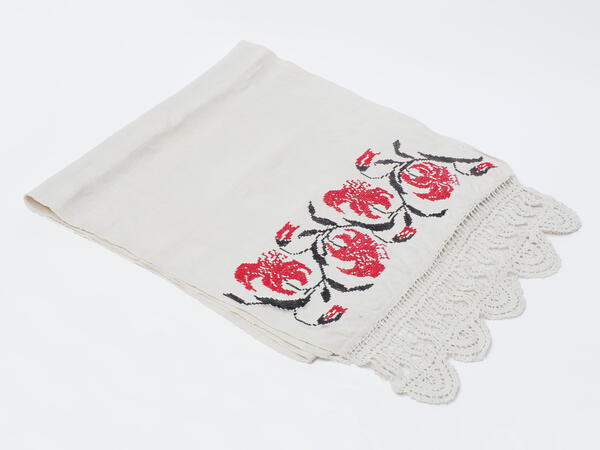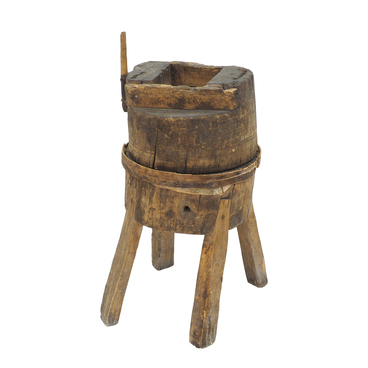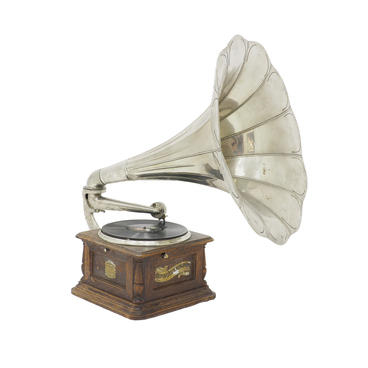This homespun towel was brought from an ethnographic expedition in 1994. It was donated to the museum by Feoktista Petrova (nee, Nikulina), who is an old inhabitant of the Yarskoe village, Tomsk district, and the head of the Yarsk folk choir.
The towel was made in the late 19th — early 20th century on a hand loom called ‘krosna’. A narrow sheet was woven on ancient textiles reeds, which are special machine boards with plenty of longitudinal pikes. Usually, the woven sheets were long — about three meters long. However, the towel from the museum collection was shortened — the central part was removed.
The towel was usually bleached after it was finished. The woven product was boiled in ash solution, then rinsed several times, and spread out on the snow. After that the linen became snow-white and soft.
These goods were often decorated with embroidery. The towel from the museum collection is decorated with a floral pattern. The embroidery consists of a horizontal twisting branch, leaves, buds, and lily-like flowers looking in different directions. The embroidery is made in small cross-stitches of red and black cotton threads.
The black and red pattern against the white background was a traditional embroidery in the north of Russia. It became popular on the territory of Siberia thanks to the first settlers.
The craftswoman decorated the edges of the towel with lace. She used linen threads to hook a geometric ornament with a round border around the edges also known as festoons. Lacemaking replaced the old way of trimming the ends of towels with long tassels. Previously they were made of linen threads and intertwined as a net in their upper part. Legend has it that such towels protected households from evil. An evil eye or jinx could be removed if the person wiped his or her face with this towel. In this case, everything bad would flow along these tassels and leave the house.
Russians often used homespun towels in their everyday life. They are still considered a symbol of traditional Russian culture. Each maiden prepared several dozen towels for her own dowry — she weaved, embroidered, and put them into a chest. During the wedding, they were hung on the walls inside the house so as to demonstrate the bride’s skill. The bride gave the towels as a gift to her mother-in-law and other husband’s relatives, she tied them on the bridesman’s chest (he was called “druzhka”). The honored guests were usually greeted with bread and salt on an embroidered towel.
The towel was made in the late 19th — early 20th century on a hand loom called ‘krosna’. A narrow sheet was woven on ancient textiles reeds, which are special machine boards with plenty of longitudinal pikes. Usually, the woven sheets were long — about three meters long. However, the towel from the museum collection was shortened — the central part was removed.
The towel was usually bleached after it was finished. The woven product was boiled in ash solution, then rinsed several times, and spread out on the snow. After that the linen became snow-white and soft.
These goods were often decorated with embroidery. The towel from the museum collection is decorated with a floral pattern. The embroidery consists of a horizontal twisting branch, leaves, buds, and lily-like flowers looking in different directions. The embroidery is made in small cross-stitches of red and black cotton threads.
The black and red pattern against the white background was a traditional embroidery in the north of Russia. It became popular on the territory of Siberia thanks to the first settlers.
The craftswoman decorated the edges of the towel with lace. She used linen threads to hook a geometric ornament with a round border around the edges also known as festoons. Lacemaking replaced the old way of trimming the ends of towels with long tassels. Previously they were made of linen threads and intertwined as a net in their upper part. Legend has it that such towels protected households from evil. An evil eye or jinx could be removed if the person wiped his or her face with this towel. In this case, everything bad would flow along these tassels and leave the house.
Russians often used homespun towels in their everyday life. They are still considered a symbol of traditional Russian culture. Each maiden prepared several dozen towels for her own dowry — she weaved, embroidered, and put them into a chest. During the wedding, they were hung on the walls inside the house so as to demonstrate the bride’s skill. The bride gave the towels as a gift to her mother-in-law and other husband’s relatives, she tied them on the bridesman’s chest (he was called “druzhka”). The honored guests were usually greeted with bread and salt on an embroidered towel.



